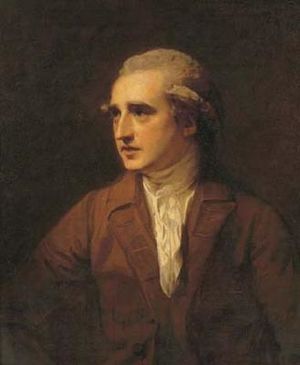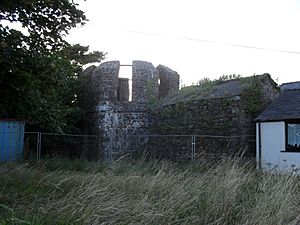Charles Francis Greville facts for kids
Quick facts for kids
Charles Francis Greville
|
|
|---|---|

Greville by George Romney
|
|
| Treasurer of the Household | |
| In office 1783–1784 |
|
| Monarch | George III |
| Prime Minister | William Pitt the Younger |
| Preceded by | The Earl of Effingham |
| Succeeded by | The Earl of Courtown |
| Vice-Chamberlain of the Household | |
| In office 1794–1804 |
|
| Monarch | George III |
| Prime Minister | William Pitt the Younger Henry Addington |
| Preceded by | Lord Herbert |
| Succeeded by | Lord John Thynne |
| Personal details | |
| Born | 12 May 1749 |
| Died | 23 April 1809 (aged 59) |
| Nationality | British |
Charles Francis Greville (born May 12, 1749 – died April 23, 1809) was an important British figure. He loved old things, collected many interesting items, and was a politician. He served in the House of Commons, which is part of the British Parliament, from 1774 to 1790. He was also a member of the Royal Society, a famous group for scientists.
Contents
Early Life and Family
Charles Francis Greville was born into a noble family. His father was Francis Greville, 1st Earl of Warwick. Charles was the second son of his parents. He grew up at Warwick Castle, a very old and grand family home.
His father was given the title of Earl Brooke before Charles was born. Later, in 1759, his father also became the Earl of Warwick. This was a very old and respected title. Charles studied at the University of Edinburgh from 1764 to 1767.
Amazing Collections
Charles Greville was known for his love of collecting. He had a special interest in many different things.
Art and Ancient Objects
Even though he had a limited income, Greville managed to buy ancient objects from Rome. He also bought a painting by Annibale Carracci. His uncle, Sir William Hamilton, was a British diplomat in Naples. Sir William also collected many ancient Greek vases. One of his collections is now at the British Museum.
Minerals and Stones
As a member of the Royal Society, Greville was very interested in minerals and precious stones. He had a large collection that was carefully listed by a scientist named Jacques Louis, Comte de Bournon. This collection was later bought by the British government for the British Museum. Greville was good friends with James Smithson, who later founded the Smithsonian Institution in the United States. They often traded minerals with each other.
Gardening and Plants
Greville was also a close friend of Sir Joseph Banks, a famous botanist. Like Banks, Greville was a member of the Society of Dilettanti, a group that supported the arts. He helped organize a meeting in 1804 that led to the creation of the Royal Horticultural Society. This society helps people learn about and grow plants.
Greville loved gardening. He had a large garden at his home in Paddington Green, London. He grew many rare tropical plants in glasshouses. He was the first person to make a Vanilla planifolia plant flower indoors in England. This happened in the winter of 1806–07. His plant samples are kept by the Linnean Society of London. A type of plant called Grevillea was named after him.
Portraits of Emma Hamilton
Charles Greville helped a young woman named Amy Lyon. He gave her the name Mrs. Emma Hart. He helped her get an education. He also took her to the studio of George Romney, a famous artist. Romney was very impressed by Emma's beauty. He painted many portraits of Emma, showing her in different roles. Greville kept these paintings in his house until he died.
Political Career
When his father passed away in 1773, Charles's older brother became the Earl of Warwick. This meant Charles could take his brother's place in Parliament. He became a Member of Parliament (MP) for the town of Warwick in 1774. He held this position until 1790.
During his political career, he held several important roles:
- He was a Lord of the Treasury from 1780 to 1782.
- He served as Treasurer of the Household from 1783 to 1784.
- He was Vice-Chamberlain of the Household from 1794 to 1804.
He also became a member of the Privy Council in 1783. This is a group of important advisors to the King.
Milford Haven Project
Charles Greville was very active in developing the seaport of Milford Haven in South Wales. This area was owned by his uncle, Sir William Hamilton. Greville worked to get a special law passed by Parliament. This law allowed them to build docks, quays (places for ships to load and unload), and markets. They also built roads and planned the town.
The first building was a coaching inn. Greville also encouraged Quaker whaling ship owners from Nantucket to move there. For many years, Milford was an important whaling port. During the Napoleonic Wars, a royal dockyard was built there for the navy. When his uncle died in 1803, Milford Haven was left to Greville.
Greville also planned to build a college called the College of King George the Third in nearby Hakin. This college would teach mathematics and navigation. The main part of the college was meant to be an observatory. The observatory was built, and scientific tools were delivered. However, the college itself never fully opened. After Greville died in 1809, the whole project was stopped.
Personal Life
Charles Greville never married. He helped Emma Hamilton when she was in a difficult situation. He took her in and helped her. He later helped arrange for her to meet and marry his uncle, Sir William Hamilton.
He spent many years living in a house he built near Paddington Green. This was a village outside London at the time. He kept Romney's paintings of Emma on his walls. Later in his life, he lived at Warwick Castle. Charles Greville passed away on April 23, 1809, at the age of 59.
Recognition and Legacy
The plant genus Grevillea, which includes about 360 different types of evergreen plants, is named after Charles Greville. This was done to honor his support for botany and his role in starting the Royal Horticultural Society. Greville Island, in the South Island of New Zealand, was also named after him in 1820.
Charles Greville also appears as a character in the 1992 novel The Volcano Lover by Susan Sontag. The book is about his uncle, Sir William Hamilton.


